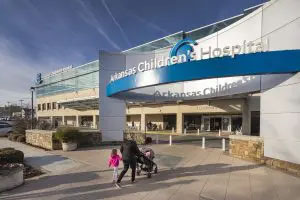At Arkansas Children’s, we truly live by our mission of making children better today and healthier tomorrow. This has been our practice since the 1920s when we were founded and operated as an orphanage run by volunteers. Needless to say, we’ve seen quite an evolution over the last 100 years – and today we’re a nationally recognized pediatric health center ranked by the U.S. News & World Report’s 2021-22 Best Children’s Hospitals Ratings for Cardiology & Heart Surgery, Nephrology, Pulmonology, and Urology.

Many believe that achieving excellence in pediatric care is the result of hiring best in class healthcare providers and adopting state of the art medical innovations. While these people are right, they’re also missing a big piece of the picture.
This kind of evolutionary achievement is also made possible through strategic collaboration and partnership with individuals and organizations; those that share in our core values of safety, teamwork, compassion, and excellence. And those that go the extra mile to exemplify those values in their day-to-day work.
Patient care delivery can only be as good as the IT infrastructure that supports it.
When I came on board as the applications development director at Arkansas Children’s, I realized that our departmental IT systems weren’t communicating with one another, which meant our clinicians weren’t seeing the full patient picture. We needed to make major IT infrastructure changes to ensure the highest standards of care were being met for our young patients. This meant we needed to seek a new enterprise imaging partner.
We started our search by seeking a PACS system that would help with the interoperability of our radiology imaging. We wanted something that would run server-side, bringing both our radiologists and IT teams greater flexibility. It was also important that we selected technology that could scale to meet our imminent growth – because if the last 100 years taught us anything, it’s that we’re poised for continued growth.
We embarked on our search to partner with a technologically-forward company that provided a zero-footprint viewer, which narrowed the field tremendously. While Fujifilm was already on our short list, the company’s acquisition of TeraMedica pushed the organization to the top of our list because we knew this meant the company could support our enterprise architectural needs.
We made the decision to partner with Fujifilm and install their Synapse Enterprise Imaging portfolio. We’ve seen great success since the implementation.
Being a Level 1 Trauma Center, it’s critical that our resources help our team to make the quick, life-saving decisions that we’re known for. With Fujifilm’s Synapse Enterprise Imaging solutions, clinicians have immediate access to patient imaging allowing them to make split second decisions that drive better patient outcomes.
From an IT perspective, we struggled with our previous incumbent solution because it required us to use physical hardware. Not having to manage 60+ PACS reading workstations is a game changer. In addition to our radiologists having PACS at home, now every single location that any doctor logs in from, including their home, has access to Synapse Mobility allowing them to see images from their house, phone, or whatever workstation they log into.
Fujifilm is a valued partner of ours, so much so we collaborated on the development of a case study. Click here to see the additional clinical and IT benefits Arkansas Children’s has seen since the Synapse installation.
 By Andy Dick
By Andy Dick
Vice President of Information Systems Applications
Arkansas Children’s Hospital